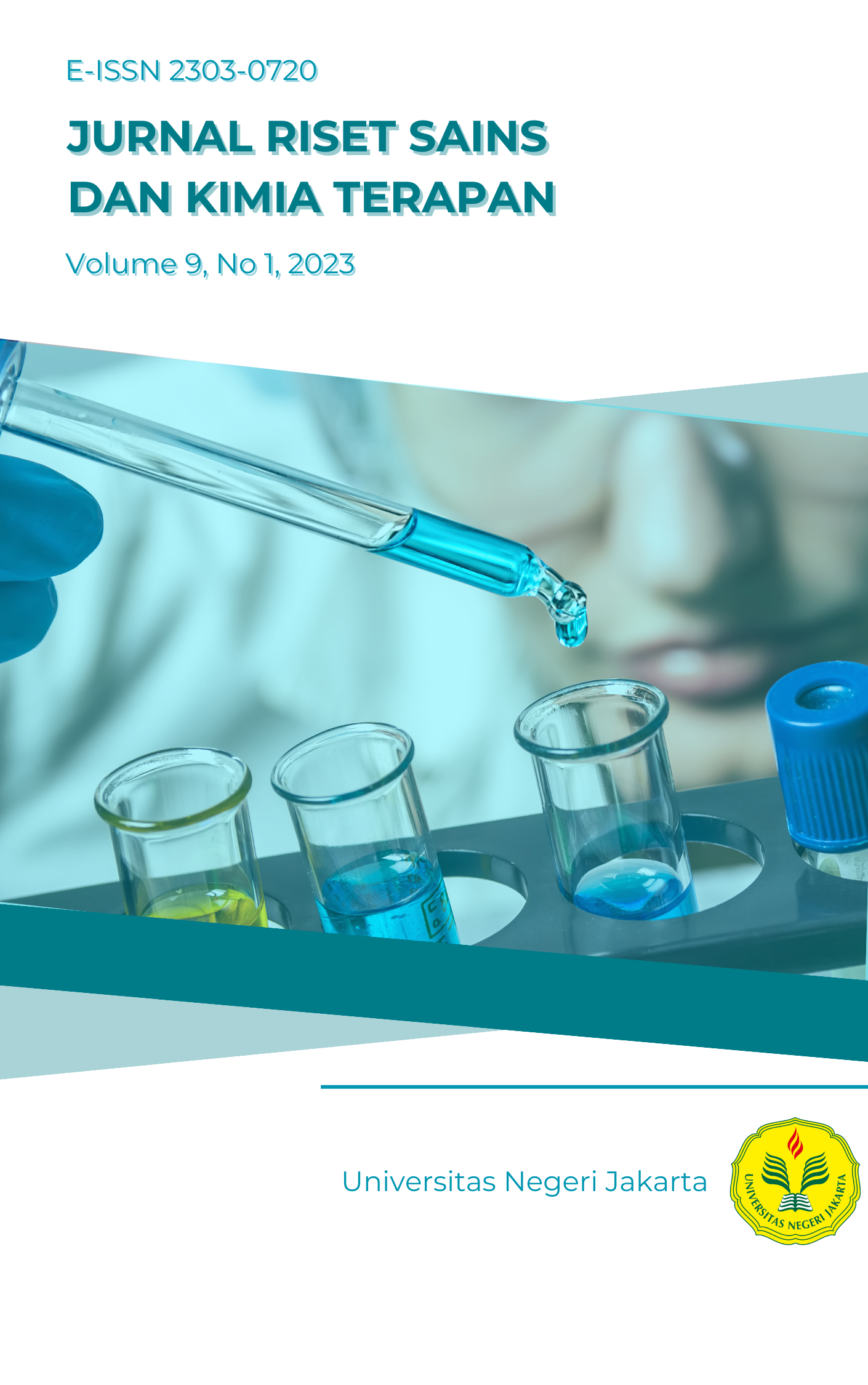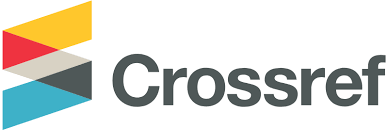Ekstraksi Karbon Aktif Bebas Silika dari Arang Sekam Padi untuk Adsorpsi Zat Warna Methyl Orange
Abstract
Abstrak
Ekstrak karbon aktif bebas silika disintesis dari arang sekam padi berhasil diperoleh melalui perbandingan mol karbon:NaOH sebesar 1:3. Hasil karakterisasi SEM pada karbon aktif menunjukkan morfologi materialnya berbentuk butiran dan hasil karakterisasi EDX menunjukkan komposisimya terdiri dari 93.29% karbon; 6.71% oksigen dan 0% silika. Hasil karakterisasi FTIR karbon aktif bebas silika menunjukkan tidak adanya puncak silika pada bilangan gelombang 1100 cm-1. Berdasarkan hasil karakterisasi SAA, karbon aktif bebas silika memiliki luas permukaan sebesar 6.0018 m2g-1 yang tergolong jenis mikropori. Proses adsorpsi dari karbon aktif bebas silika dalam penyerapan zat warna methyl orange optimum pada massa adsorben sebanyak 200 mg dan maksimum pada massa adsorben 250 mg.
Kata kunci: adsorpsi, karbon aktif bebas silika, methyl orange.
Abstract
The extraction of activated carbon free silica from rice husk with 1:3 mole ratio of carbon : sodium hydroxide has been successfully performed. The SEM result on activated carbon show the morphology of the material is granular and the EDX result showed the composition consisted of 93.29% carbon, 6.71% oxygen, 0% silica. The result of characterization FTIR not showing silica any peak of silica in wavelength 1100 cm-1. Based of characterization of SAA, indicates the material of activated carbon free silica has a surface area of 6.0018 m2/g, has a microporous type. The adsorption process on methyl orange pigment optimum at 200 mg and maximum at 250 mg.
Keywords: adsorption, activated carbon free silica, methyl orange.
References
Cavallo, A., & Dino, G. A. (2022). Extractive Waste as a Resource: Quartz, Feldspars, and Rare Earth Elements from Gneiss Quarries of the Verbano-Cusio-Ossola Province (Piedmont, Northern Italy). Sustainability, 14(8), 4536. https://doi.org/10.3390/su14084536
Gou, Z., Hopla, G. A., Yao, M., Cui, B., Su, Y., Rinklebe, J., Sun, C., Chen, G., Ma, N. L., & Sun, Y. (2022). Removal of dye pollution by an oxidase derived from mutagenesis of the Deuteromycete Myrothecium with high potential in industrial applications. Environmental Pollution, 310, 119726. https://doi.org/10.1016/j.envpol.2022.119726
Gürses, A., Güneş, K., Şahi̇nE., & Açıkyıldız, M. (2023). Investigation of the removal kinetics, thermodynamics and adsorption mechanism of anionic textile dye, Remazol Red RB, with powder pumice, a sustainable adsorbent from waste water. Frontiers in Chemistry, 11. https://doi.org/10.3389/fchem.2023.1156577
Higueras, P. L., Sáez-Martínez, F. J., Lefebvre, G., & Moilleron, R. (2018). Contaminated sites, waste management, and green chemistry: new challenges from monitoring to remediation. Environmental Science and Pollution Research, 26(4), 3095–3099. https://doi.org/10.1007/s11356-018-3564-z
Iftikhar, S., Zahra, N., Rubab, F., Sumra, R. A., Khan, M. B., Abbas, A., & Jaffari, Z. H. (2023). Artificial neural networks for insights into adsorption capacity of industrial dyes using carbon-based materials. Separation and Purification Technology, 326, 124891–124891. https://doi.org/10.1016/j.seppur.2023.124891
Jagiello, Z., Corsini, M., Dylewski, Ł., Ibáñez-Álamo, J. D., & Szulkin, M. (2022). The extended avian urban phenotype: anthropogenic solid waste pollution, nest design, and fitness. Science of the Total Environment, 838, 156034. https://doi.org/10.1016/j.scitotenv.2022.156034
Khoshsepehr, Z., Alinejad, S., & Alimohammadlou, M. (2023). Exploring industrial waste management challenges and smart solutions: An integrated hesitant fuzzy multi-criteria decision-making approach. Journal of Cleaner Production, 420, 138327. https://doi.org/10.1016/j.jclepro.2023.138327
Kordi, M., Farrokhi, N., Pech-Canul, M. I., & Ahmadikhah, A. (2023). Rice Husk at a Glance: From Agro-Industrial to Modern Applications. Rice Science. https://doi.org/10.1016/j.rsci.2023.08.005
Noirbent, G., Pigot, C., Bui, T.-T., Péralta, S., Nechab, M., Gigmes, D., & Dumur, F. (2021). Dyes with tunable absorption properties from the visible to the near infrared range: 2,4,5,7-Tetranitrofluorene (TNF) as a unique electron acceptor. Dyes and Pigments, 189, 109250. https://doi.org/10.1016/j.dyepig.2021.109250
Nyashina, G. S., Shlegel, N. E., Vershinina, K. Yu., & Strizhak, P. A. (2018). Industrial Waste as Part of Coal–Water Slurry Fuels. Energy & Fuels, 32(11), 11398–11410. https://doi.org/10.1021/acs.energyfuels.8b02826
Samsalee, N., Meerasri, J., & Sothornvit, R. (2023). Rice husk nanocellulose: Extraction by high-pressure homogenization, chemical treatments and characterization. Carbohydrate Polymer Technologies and Applications, 6, 100353. https://doi.org/10.1016/j.carpta.2023.100353
Serban, G. V., Iancu, V. I., Dinu, C., Tenea, A., Vasilache, N., Cristea, I., Niculescu, M., Ionescu, I., & Chiriac, F. L. (2023). Removal Efficiency and Adsorption Kinetics of Methyl Orange from Wastewater by Commercial Activated Carbon. Sustainability, 15(17), 12939. https://doi.org/10.3390/su151712939
Sun, Q., Li, Y., Su, Y., Wei, M., Li, H., & Liu, J. (2023). Determination of restricted dyes in textile raw material solid wastes by ultra-high performance liquid chromatography-tandem mass spectrometry. Journal of Chromatography A, 1711, 464447–464447. https://doi.org/10.1016/j.chroma.2023.464447
Valentini, F., Cerza, E., Campana, F., Marrocchi, A., & Vaccaro, L. (2023). Efficient synthesis and investigation of waste-derived adsorbent for water purification. Exploring the impact of surface functionalization on methylene blue dye removal. Bioresource Technology, 390, 129847–129847. https://doi.org/10.1016/j.biortech.2023.129847
Wu, L., Liu, X., Lv, G., Zhu, R., Tian, L., Liu, M., Li, Y., Rao, W., Liu, T., & Liao, L. (2021). Study on the adsorption properties of methyl orange by natural one-dimensional nano-mineral materials with different structures. Scientific Reports, 11(1), 10640. https://doi.org/10.1038/s41598-021-90235-1
Copyright (c) 2023 Jurnal Riset Sains dan Kimia Terapan

This work is licensed under a Creative Commons Attribution 4.0 International License.


_1.png)


